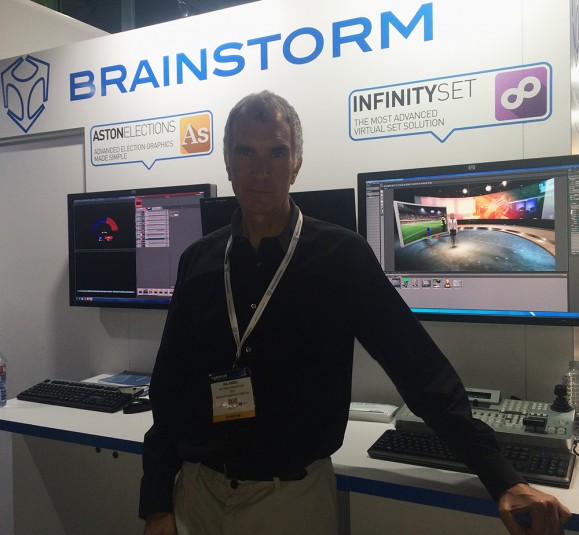SVG@NAB Perspectives: Brainstorm’s Montesa on New Features of the Company’s Virtual-Set Technology
At NAB 2016, Brainstorm Multimedia rolled out a 24-ft.-wide virtual-studio theater to showcase the latest features of its Infinity Set virtual-set application enhanced by graphics and other content created by the Aston 3D.
The hands-tracking feature — which enables presenters to trigger animations and graphics with the simple hand movements — is part of Brainstorm’s TrackFree technology, which offers tracking capabilities without external hardware required. Top of the list of “must see” features available thanks to TrackFree is the TeleTransporter, the company’s “virtual traveler” feature, which was introduced at NAB 2015 and allows users to insert talent into a set at any remote location using independent camera-tracking technology. Another TrackFree-based feature, 3D Presenter, generates a true 3D representation of the live presenter, allowing talent to cast virtual shadows and reflections over real and 3D objects within the virtual environment.
Also on display were Brainstorm’s Aston Elections graphics solution, eStudio V14 render engine, and Aston 3D graphics creation, CG, and playout solution.
During the show, SVG sat down with Brainstorm CEO Ricardo Montesa to discuss how Infinity Set and TrackFree virtual technology are allowing live sports productions to break down creative walls and find new, efficient strategies for producing studio content at-home rather than onsite.
How is Brainstorm highlighting the TeleTransporter and 3D Presenter technologies in Infinity Set this year?
We have been doing virtual sets for more than 20 years, so this is an evolution of the technique. In the past, traditionally, what everybody was doing was overlaying two pictures — one from the camera, one from the background — and matching the perspective. However, what we are doing now is not overlaying two pictures but capturing the talent as a 3D element. We make a real 3D representation of the talent, and, because of that, the talent can be used as a virtual-reality element. It is not just graphics and advertising but the talent itself that we can [manipulate].
The talent is casting their shadow, refocusing, and matching the background with color corrections, so it looks to the audience like the talent is really [at the remote location]. We can do this live as we have demonstrated here. We can also transmit the tracking information with the video signal, so the camera can be on a soccer field and in the game, and the talent can be in the TV station. That means that the talent could [appear] in one game and then in another game and then another and show the information on what is happening in different places — all minutes apart.
How have virtual sets allowed sports-production outlets to create more studio programming at a lower cost?
We have never liked the idea of using [a virtual studio] just for cost savings. When we started virtual sets, people asked us about saving on studio and advertising [costs], but this is not really the reason you use this technology. You use a virtual set because you can do things that you cannot do in real life. We do elections, and we put all those graphics coming from the floor in the background: pies, charts, and tables of data. We take advantage of the virtual environment to show information that would not be possible to [display] in real life. If you just want to replace a background, pay some carpenters and get some computers, and everything is much simpler day-to-day; there is complexity and calibration in a virtual set.

Brainstorm’s 24-ft.-wide-virtual studio theater demonstrated how Infinity Set’s TeleTransporter feature virtually inserts talent into a remote location.
However, if you are a broadcaster with [limited] resources, you may not [be able to] send people to different games in different places every week to report. It is not possible to pay for all the travel costs. But, if the video signal is coming to you with embedded tracking information, we can send [reporters] to the game virtually. So you are at the game [and] capture the video and the tracking data and send it back to the studio. The video signal knows the camera position for every frame. Now we can use that information to put your talent inside the with shadows, lighting, everything, as if they are right here. And the same signal can go to many TV stations.
For sports, it is [a great] application, because. every weekend and every day. there is another game. It can be done live, but it can also be done recorded. So, if you record any sequence and you realize half an hour later that you want to do a [virtual live report], we can get the tracking data for that moment, and we can use it the same as if we were using it live in the show.
In what sector are you seeing growth for virtual sets?
We are growing now in the smaller [customers]. Years ago, it was about big broadcasters like CNBC or BBC or NBC or ESPN, but now, because of the simplicity of the software, we are seeing more [lower-tier customers] interested. Everything we have shown here is done with a tripod in a fixed camera, no complexity for tracking, calibrations, and mechanical devices that have to be maintained and tweaked and positioned properly. It’s very simple: it’s just a fixed camera. And the price is much cheaper than it used to be. Now there’s an opportunity opening for those broadcasters that aren’t at the top level and don’t necessarily have the money or the technicians or knowledge. We now have the solutions that are much better for that situation.

